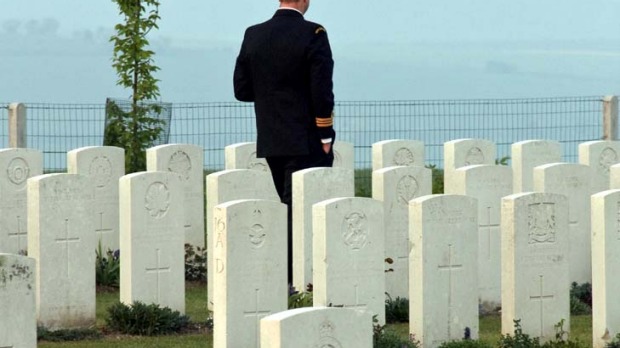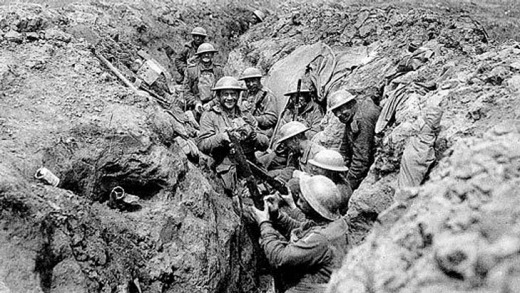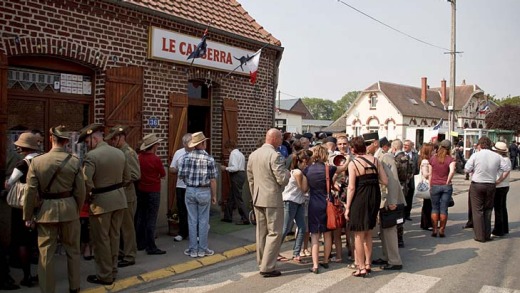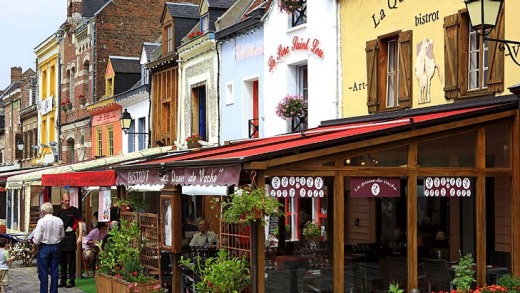
It is the biggest day of the year in Bullecourt. At least, it is for the town's seventy-something mayor, who can barely contain his pride. Diggers and dignitaries mingle with pilgrims and the public as the mayor works the room like an elderly rock star, posing for photos with Australians, kissing women on both cheeks and leading a bemused Australian foreign minister around practically by the lapels, much to the exasperation of the security staff trailing behind them.
Outside the reception overflows on to the lawn and those not inclined to drink the French bubbles on offer gravitate to the Le Canberra pub next door. A stranger puts a beer in my hand. I buy a round for a few Diggers in uniform. All that's missing is a game of two-up. It's been an incredible Anzac Day on the Western Front and everyone's proud they made the journey.
For better and for worse, a massive industry has sprung up to accommodate battlefield tourism, to the extent where bookings are already being taken for tours to attend the 100th anniversary dawn service at Gallipoli in 2015.

However, doing the trip independently allows you the freedom to explore at your own pace. The Anzac Day memorial services held in France remain the most accessible, with the Somme an easy two hours by train from Paris.
Driving in from Belgium, the fields of white headstones signal we've arrived in the Somme. Of the 290,000 Australians who served in World War I, 46,000 were killed, buried among allies and enemies in hundreds of cemeteries scattered across the region.
There's a sense of reverence for this day in the Somme.
There are too many to visit them all, so randomly we pull over at one on the outskirts of Villers-Bretonneux. Unwittingly, I've already found a thread to home; this is the cemetery where the Unknown Soldier, now interred in the Hall of Memory at the Australian War Memorial in Canberra, was originally buried.

It is easy to see why he was chosen from this cemetery; of the hundreds of graves here, most bear the lonely epitaph "A Soldier of the Great War". Stripped of nationality, religion, race and age, it's a reminder that in war, death is a great equaliser. The anonymity of these lost sons, brothers and husbands hits me hard, and it's the first time on this trip I shed the tears the Western Front demands of all visitors.
We continue on into the town of Villers-Bretonneux, passing a town hall adorned with kangaroo emblems and buildings draped with Australian flags.
On the evening of the 24th and early morning of the 25th of April, 1918 (ironically, the three-year anniversary of the landing at Gallipoli), brigades from the 4th and 5th divisions of the Australian Infantry recaptured the occupied town of Villers-Bretonneux and stopped the German advance. The Australians were welcomed with open arms by the townspeople. Today, they still are.

The town celebrates Anzac Day with concerts and walks, talks and a friendly Aussies v locals AFL match in the days leading up to April 25. We watch the cycling race ceremony from the Melbourne pub, cheering on the locals the Australian way, with a beer in hand.
We wander through the Franco-Australian Museum, home to a collection of relics - uniforms and letters from the Great War. It's housed in the rafters of the Victoria School, which was rebuilt with money raised by Victorian school children after the war. A large bilingual plaque outside the entrance commemorates the relationship, but it's the inside of the schoolyard, where foot-high letters spell out "Do not forget Australia", that evokes the most pride.
As much as I'm in awe of the reverence and celebration for all things Australian in the town, it's bewildering for my Dutch partner, who simply cannot believe the gratitude shown by this tiny French town to Australia.
The hospitality continues in Amiens. On check-in at the Mercure Amiens Hotel, a better driving route to the dawn service is photocopied and mapped out for us, wake-up calls have already been arranged and we're rushed up to the stunning cathedral to see it just before closing time. When we rise at 3am the next day, urns of hot coffee and tea and proper china teacups are waiting in the foyer for hundreds. It's not something they have to do. They do it because there's a sense of reverence for this day throughout the Somme.
We're among the first to arrive for the dawn service near Villers-Bretonneux at the Australian National Memorial, made up of a central tower flanked on either side by two walls. Opened in 1938, the memorial lists the names of the 10,773 Australians who died in France with no identified grave.
Over the next few hours the site swells with people; kids in school blazers, soldiers in uniform, grey nomads in fleeces and dignitaries in crisp suits. The service begins and the appropriate speeches are made. Anthems are belted out with pride. Bands play. Poems are read. Tears fall. A moment's silence of remembrance dominates.
And then a lone bugler stands on the tower that forms the centre of the memorial. The Last Post plays as the sunlight begins to streak into a cloudless sky, rising to a magnificent golden orb that casts long shadows across the crowd of thousands.
During World War II, both sides prized this memorial for its strategic position overlooking the Somme. The dawn light reveals one of the memorial's secrets; it is still scarred from shelling that occurred during World War II.
After the reveille plays, the flags are raised from half-mast, signalling the dawn service is finished. Most tour buses pack up and head to Paris or Calais after a wreath-laying service in town. But free of someone else's schedule, we sneak back into Amiens for a catnap before heading to Bullecourt for a more intimate service in the afternoon.
Bullecourt was the scene of some of the Great War's most intense trench warfare. Two major battles were fought here in an attempt to hold the Hindenburg Line. The first, in April 1917, cost 3000 Australian lives. The second, in mid-May, resulted in 7000 casualties.
Today Bullecourt is a tiny village. Unlike the thousands who attended the dawn service, just a few hundred have continued on for the afternoon service. Most stand in the shade to protect themselves from the scorching sun, a contrast to the pre-dawn chill we'd experienced that morning, and a sharp reminder of the extremes the Diggers faced.
Two dozen elderly French veterans wearing medals act as flag bearers in the heat, as wreaths, wilting under the baking sun, are laid first at the memorial for the Australians, then at the French one just a few steps across the street. But it's what happens next that defines my Anzac Day experience.
The children of Bullecourt, each carrying a small posey of flowers, lead the way. The younger ones, three or four and a little unsure of what is going on, clutch the hands of their siblings for courage. The crowd walks behind them in silence to the outskirts of town, along a road named the Rue des Australiens to the Australian "Digger" Memorial.
As we walk, I think about a line from a speech at the dawn service that morning. "Tread lightly" the speaker implored, "for today we walk among giants". Walking through the fields where so many Australians gave their lives, I'm glad we're led by children.
John McCrae's iconic poem In Flanders Fields is read as the children lay their flowers underneath a statue of a Digger. The final lines carry a poignant message for those who have gathered here on the Western Front: "To you from falling hand we throw/The torch; be yours to hold it high."
The writer was a guest of Accor Hotels.
In the days before and after Anzac Day some sites can be crowded or have limited access due to ceremonies. Visiting the battlefields outside of Anzac Day can be a more intimate and fulfilling experience.
For the Somme, www.visit-somme.com offers comprehensive information, including a "Circuit of Remembrance" with information on visiting the major sites by plane, steam train or horse and cart. It's also worth considering visiting nearby Flanders in Belgium to attend the nightly memorial in Passchendaele. Since 1928, locals have paid tribute to the soldiers lost in the Great War by playing the Last Post at the Menin Gate at 8pm every evening.
Taking a tour can greatly enhance your visit to the Somme. Look for local, recommended operators offering small group tours that focus on Australia's role in the war and be sure to communicate in advance if you have an interest in visiting the graves of ancestors.
Getting there
The Somme is in the north-east of France, about two hours from Paris. Amiens, the closest city to Villers-Bretonneux, is a major rail hub.
Staying there
The Mecure Amiens Cathedrale (21 Rue Flatters) has 102 rooms and is highly recommended. (+33) 32 280 6060, accorhotels.com. Villers-Bretonneux is 18 kilometres east of Amiens. A free shuttle service is available through anzac-france.com. Book as far ahead as possible as seats sell out.
Driving there
Hertz France offers car hire from Paris and Amiens: hertz.fr. On Anzac Day, this writer had no problem finding a park for the dawn service (everyone pulls over on the grass along the side of the road and walks up), and getting there a bit earlier means a better seat for the service.
anzac-france.com; www.dva.gov.au/france